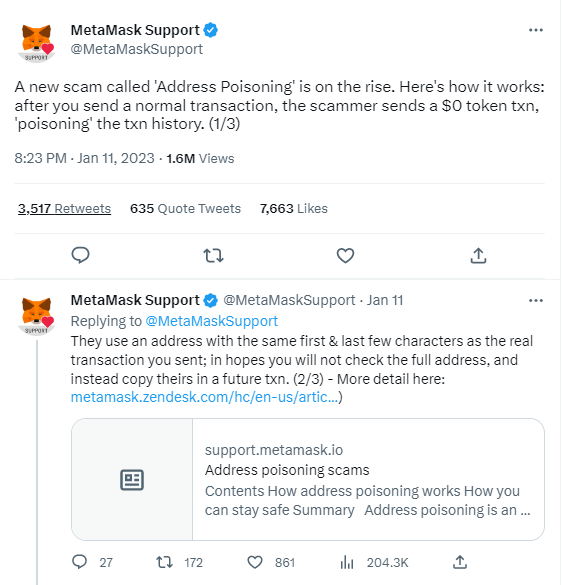If moving large sums of cryptocurrency makes your palms sweat, test transactions can put your mind at ease. Sending a small amount of Bitcoin (BTC) or Ethereum (ETH) as a tester can protect you from address-poisoning scams and help you keep your digital currencies safe and secure on the blockchain.
Test transactions are a great way to learn more about blockchain technology and figure out how certain smart contracts work. Used effectively, they also help you detect sandwich bots and safeguard you from other nefarious actors.
What are test transactions? Why do some of crypto’s brightest minds use them, and is there any reason not to?
What Is a Test Transaction?
If you’ve ever deposited or withdrawn cryptocurrencies like Bitcoin or Ethereum on an exchange, you’re probably familiar with this kind of warning:
The thought of losing everything due to incorrectly inputting a complicated wallet address or network is certainly intimidating. Thankfully, sending a small test transaction through a blockchain system relieves these concerns. Even Vitalik Buterin, the founder of the Ethereum blockchain, often uses test transactions before sending large sums.

As the name suggests, these transactions are a simple testing tool to ensure your funds will be received by the crypto wallet or exchange indicated. It’s a way of checking that your public blockchain network or distributed ledger is working correctly. Test transactions confirm that you haven’t put the wrong address when transferring your crypto.
Why Should I Use Test Transactions?
Test transactions put your mind at ease. Whether it’s a simple crypto transfer, smart contract testing, or trialing different types of blockchains, test transactions let you confirm that everything works as it should.
While some may say it’s a waste of fees or time, the fact that a simple test could save you thousands is worth remembering. If you accidentally input the wrong address, would you rather send the lucky recipient $1 or everything you have?
Small testers aren’t limited to transfers alone. Unfortunately, there is no shortage of scammers in the crypto space. Some blockchain applications in the DeFi Wild West are specifically designed to catch unwary users.
What Can Test Transactions Protect Me From?
Despite the prevalence of bad actors trying to cheat you out of your hard-earned crypto, most scams can be detected and avoided by test transactions. To help you keep safe out there, here are a few common examples:
Address Poisoning
Address Poisoning is a technique wherein scammers send a $0 transaction to your wallet using an address with the same first and last characters as yours. Scammers hope you won’t double-check the small details, like your full wallet address, before sending funds and that you’ll accidentally copy-paste their address instead of your own.

Test transactions make address poisoning easily avoidable. If your transfer is correctly received at the intended address, you know you haven’t unknowingly input a fake address.
Sandwich Attacks
While sandwich attacks aren’t technically a scam, they take advantage of user carelessness in the ecosystem and can be avoided with a test transaction. In short, sandwich attacks are performed by Ethereum miners when creating new blocks.
By altering the order of transactions in a new block, MEV (Miner Extractable Value) bots can front-run token trades on a decentralized exchange and immediately dump on buyers.
For example, I buy $1,000 worth of a token. In one block, an MEV bot can buy $10,000 worth of the same token and pump the price of my purchase, only to instantly back to me.

This poor soul tried to buy $3M worth of $rDPX but only received around $600 due to a brutal sandwich attack. A small test transaction will highlight any irregularities in the trade and protect you from being a victim of MEV bots.
Honeypots
Some blockchain-based token contracts are designed with purely evil intentions. Another typical scam in decentralized finance, a honeypot, is a token that cannot be sold. Like a mouse in a pot of honey, you can get in, but you can’t get out.
Instead of buying these awful tokens outright, a test trade to check that you can actually sell after buying could save you a lot of money long term.
Misplacing Funds
As your favorite crypto exchange no doubt tells you every time you make a transfer, your funds could be lost forever if you input the wrong address.
Why take the risk? One test transaction could save you a lifetime of regret.
Test Transactions – Not to Be Confused With Testnet
While test transactions are used to test specific functions on the blockchain, they’re not the same as a blockchain testnet. A testnet is a specific testing environment with ‘free’ tokens where developers can trial different codes and algorithms.
Testnets, like Ethereum Goerli or Polygon Mumbai, are used for different types of testing. This could include smart contract testing, load testing, or security testing. In some cases, blockchain developers might invite their community to test certain features of a network or application in exchange for a token reward.
In late 2022, Aptos test netters received 300 APT tokens as a reward for testing features on the network, like NFT minting and node testing.
Test Transactions in Crypto – Pros and Cons
There are many reasons why test transactions are a great tool that keeps your funds secure in the Web 3 world. Of course, in the interest of being objective, it’s important to recognize that they aren’t foolproof and do have their (slight) drawbacks.
Pros
- Test transactions help you detect avoidable scams, like address poisoning and honeypots that could cheat you out of your funds.
- Test transactions ensure your crypto goes to the correct address and network when transferring funds.
- Test transactions can help you familiarize yourself with new blockchain networks and applications and trial crypto use cases.
- Joining incentivized testnets can make you eligible for generous airdrops.
Cons
- Sending a test transaction before your main transaction means you’ll need to pay fees twice. While this isn’t a problem on affordable networks like Polygon or Solana, it could be expensive during high congestion on Ethereum.
- Test transactions take time to be processed. If you need to transfer funds quickly, sending a tester could slow you down. That said, it shouldn’t take longer than a few minutes and could save you a lot of money.
On The Flipside
- Test transactions are a security measure that requires constant diligence. Just because your test transaction worked the first time doesn’t guarantee that the same transfer will work a few months later. As Metamask says, ‘continual scrutiny’ is a valuable habit in the crypto space.
Why You Should Care
Test transactions are simple and affordable. While they might seem unnecessary sometimes, test transactions could save money and protect you from scams in the Web3 world.
FAQs
How can I check crypto transactions?
You can check the status of crypto transactions by using a blockchain explorer such as Etherscan or Blockchain.com. Simply copy the transaction ID into the field provided to check the transaction and any associated information.
Can you recover money lost in crypto?
Generally speaking, it is difficult to recover lost crypto funds. Unless you have some way of contacting the owner of the receiving wallet, it is unlikely you will ever see lost funds again.
What happens if I send crypto to the wrong network?
If you’ve sent crypto to the wrong network, you should still be able to access it by adding the network to a compatible wallet. Crypto wallets like Rabby conveniently have most blockchain networks pre-installed, making it easier to relocate misplaced funds.
Credit: Source link




























